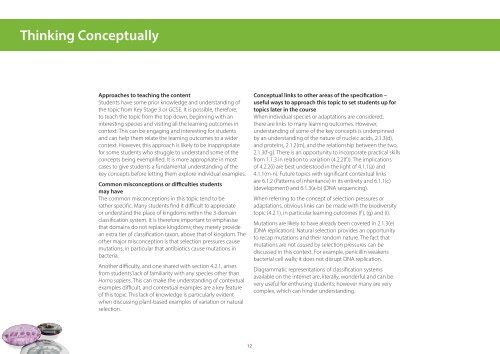BIOLOGY A
234241-classification-and-evolution-delivery-guide
234241-classification-and-evolution-delivery-guide
Create successful ePaper yourself
Turn your PDF publications into a flip-book with our unique Google optimized e-Paper software.
Thinking Conceptually<br />
Approaches to teaching the content<br />
Students have some prior knowledge and understanding of<br />
the topic from Key Stage 3 or GCSE. It is possible, therefore,<br />
to teach the topic from the top down, beginning with an<br />
interesting species and visiting all the learning outcomes in<br />
context. This can be engaging and interesting for students<br />
and can help them relate the learning outcomes to a wider<br />
context. However, this approach is likely to be inappropriate<br />
for some students who struggle to understand some of the<br />
concepts being exemplified. It is more appropriate in most<br />
cases to give students a fundamental understanding of the<br />
key concepts before letting them explore individual examples.<br />
Common misconceptions or difficulties students<br />
may have<br />
The common misconceptions in this topic tend to be<br />
rather specific. Many students find it difficult to appreciate<br />
or understand the place of kingdoms within the 3-domain<br />
classification system. It is therefore important to emphasise<br />
that domains do not replace kingdoms; they merely provide<br />
an extra tier of classification taxon, above that of kingdom. The<br />
other major misconception is that selection pressures cause<br />
mutations, in particular that antibiotics cause mutations in<br />
bacteria.<br />
Another difficulty, and one shared with section 4.2.1, arises<br />
from students’ lack of familiarity with any species other than<br />
Homo sapiens. This can make the understanding of contextual<br />
examples difficult, and contextual examples are a key feature<br />
of this topic. This lack of knowledge is particularly evident<br />
when discussing plant-based examples of variation or natural<br />
selection.<br />
Conceptual links to other areas of the specification –<br />
useful ways to approach this topic to set students up for<br />
topics later in the course<br />
When individual species or adaptations are considered,<br />
there are links to many learning outcomes. However,<br />
understanding of some of the key concepts is underpinned<br />
by an understanding of the nature of nucleic acids, 2.1.3(d),<br />
and proteins, 2.1.2(m), and the relationship between the two,<br />
2.1.3(f-g). There is an opportunity to incorporate practical skills<br />
from 1.1.3 in relation to variation (4.2.2(f )). The implications<br />
of 4.2.2(i) are best understood in the light of 4.1.1(a) and<br />
4.1.1(m-n). Future topics with significant contextual links<br />
are 6.1.2 (Patterns of inheritance) in its entirety and 6.1.1(c)<br />
(development) and 6.1.3(a-b) (DNA sequencing).<br />
When referring to the concept of selection pressures or<br />
adaptations, obvious links can be made with the biodiversity<br />
topic (4.2.1), in particular learning outcomes (f ), (g) and (i).<br />
Mutations are likely to have already been covered in 2.1.3(e)<br />
(DNA replication). Natural selection provides an opportunity<br />
to recap mutations and their random nature. The fact that<br />
mutations are not caused by selection pressures can be<br />
discussed in this context. For example, penicillin weakens<br />
bacterial cell walls; it does not disrupt DNA replication.<br />
Diagrammatic representations of classification systems<br />
available on the internet are, literally, wonderful and can be<br />
very useful for enthusing students; however many are very<br />
complex, which can hinder understanding.<br />
12


